1
Kingston's Historic Market Square is arguably the oldest commercial mart in Ontario, laid out by Lt. John Holland in 1783 as a market reserve in the original town plot. Founded in 1801, the market originally had no formal or legal entity, but served a vitally important role in this new community as a place of commerce. It was here that butchers set up shop and farmers brought their produce to sell. Market Square, in its early days, served as the focal point for the purely local trade in foodstuffs, fuel, and all the other consumables that supported day-to-day life in Kingston.In Kingston, prior to 1838, all land was either private property, church property or military reserve, with the exception of the market area, which was understood to belong to the Crown. It was recognized that there was an intrinsic need for a market in the community: without grocery stores and shops, people needed a gathering place to buy and sell goods. The market also functioned as the social centre of the town. For example, it served as a rostrum for public announcements such as Confederation in 1867, and Sir John A. Macdonald's death in 1891.
Having started as little more than an open field, by 1840 the market had evolved to consist of a series of nondescript wooden market houses known as "shambles", erected for the convenience of vendors who rented stalls within. These were extremely flimsy and did not survive the great fire of 1840. After the fire, on April 16th 1840, the town projected a new plan to revitalize the market by replacing burned tenements with publicly owned buildings. With the advent of Capital status in 1841, the town planned to build a combined City Hall and Market House, which was finished in 1844. Still the main location for everyday necessities, the new market building was a multi-storey structure with a 36-foot high central atrium surrounded by arcades housing stalls and shops for various merchants. An underground location helped to cool the area during summer and was known as the "Fresh" or "Green Market." This effectively became Kingston's first indoor shopping mall.
On January 10th 1865, yet another catastrophic fire engulfed the market building. Following this second fire, an abbreviated form of the market wing was rebuilt and the market continued in its roles as the main Kingston market for perishables and the rostrum for public announcements. Yet times were changing, and the town of Kingston was growing in size and permanence. Most other consumer items began to be more profitably sold in permanent retail stores on Store Street (now Princess Street), and by the 1890s Market Square had become known as the "Produce Market", what might today be known as a farmers' market.
The market remained in continuous operation for the first three quarters of the 20th century, though it slowly became less vital to the survival of the town as more items became readily available in permanent commercial locations. Market Square was eventually allocated to automobile parking, a reflection of the fact that it had come to be seen as unnecessary in everyday life as a market or as a public meeting place, though local tradition maintains that the Market never completely shut down,
The 1973 refurbishment of City Hall sparked a renewed interest in Kingston's Historic Market Square and led to the rejuvenation of the farmers' vegetable and fruit market. Diversification of the kind of goods available took place with vendors selling not just consumables but also flowers and arts and crafts.
In 2005, the city undertook to reclaim Market Square as a public space, refurbishing it as a skating rink in the winter and an open plaza for market days and other public gatherings throughout the year. While the Market is no longer a farmer's market in the traditional sense, and now offers a variety of artisan products, plants, produce and foodstuffs, it retains its role as a gathering place bringing people, again, to the centre of the city.
Excerpted from:
Bazely, Susan M. "Who Cares What's Under the Market Square? The Archaeological Process in Ontario and Why We Dug Up Kingston's Market Place" Historic Kingston v 55 2007:43-50.
Stage 2 Archaeological Assessment: Market Square by Susan M. Bazely
Meet You At The Market, by Hannah Roth and Earl Moorhead
2
The Land Occupied by Kingston Market Square in 18151815
Market Square, Kingston, Ontario, Canada
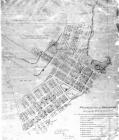 Credits:
Credits:National Map Collection 16335
3
Guard House Plan, Market Square, 18241824
Market Square, Kingston, Ontario, Canada
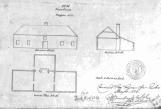 Credits:
Credits:National Map Collection 5138
4
Market Location Detail, 18321832
Market Square, Kingston, Ontario, Canada
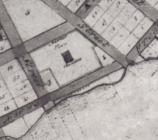 Credits:
Credits:National Map Collection
5
Kingston’s Market Block, by William H. Kilborn, 18411841
Market Square, Kingston, Ontario, Canada
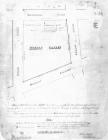 Credits:
Credits:National Map Collection 3926
6
End Elevation of the Town Hall and Front Elevation of Market House, Lower Kingston, 18421842
Market Square, Kingston, Ontario, Canada
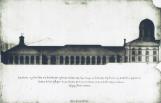 Credits:
Credits:National Map Collection 8887
7
Elevation of the Town Hall and of the Market House, Lower Kingston, 18421842
Market Square, Kingston, Ontario, Canada
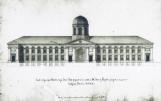 Credits:
Credits:National Map Collection 8889
8
An 1842 Elevation of the Combined City Hall and Market House1842
Market Square, Kingston, Ontario, Canada
 Credits:
Credits:National Map Collection 8888
9
Layout of the Combined City Hall and Market House from 18421842
Market Square, Kingston, Ontario, Canada
 Credits:
Credits:National Map Collection 8890
10
A Plan of the Market House, 18421842
Market Square, Kingston, Ontario, Canada
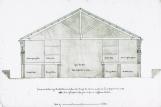 Credits:
Credits:National Map Collection 8893
11
A Poster Announcing the Ceremony Celebrating the Laying of the Market House Foundation Stone, 18432 June 1843
Market Square, Kingston, Ontario, Canada
 Credits:
Credits:Queen's University Archives
12
The City Hall/Market House Building on the Market Property, 18501850
Market Square, Kingston, Ontario, Canada
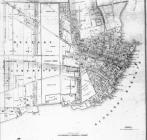 Credits:
Credits:National Map Collection 21043
13
City Hall and the Market House Building, by Alex Kewzie, 18601860
Market Square, Kingston, Ontario, Canada
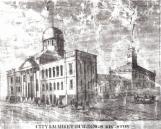 Credits:
Credits:Queen's University Archives
14
King Street Prior to the Market Fire of 1865Circa 1860
Market Square, Kingston, Ontario, Canada
 Credits:
Credits:Queen's University Archives